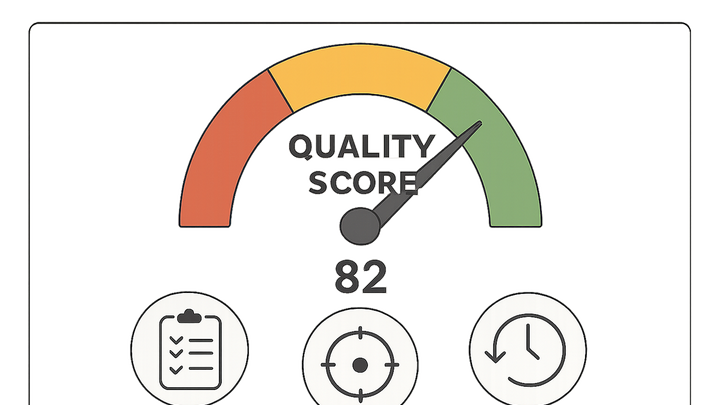Published on 2025-06-28T07:25:57Z
What is Quality Score in Analytics? Examples and Best Practices
Quality Score is a composite metric used in analytics to assess the overall quality, reliability, and completeness of your data. It helps teams understand how trustworthy their metrics are, ranging from basic pageview counts to complex event-driven analyses. In platforms like Google Analytics 4 (GA4), Quality Score can reflect factors such as sampling rates, data freshness, and attribution accuracy. With privacy-focused tools such as PlainSignal’s cookie-free simple analytics, it can also measure bot filtering and event completeness without relying on third-party cookies. By monitoring and improving your Quality Score, you ensure that business decisions, marketing optimizations, and compliance efforts are built on a solid data foundation.
Quality score
Composite metric evaluating data quality by measuring completeness, accuracy, freshness, and reliability across analytics platforms.
Why Quality Score Matters
Understanding your Quality Score helps prioritize data integrity and guides resource allocation for optimizing tracking, reporting, and decision-making processes.
-
Data-driven decisions
Use reliable data to inform strategies and reduce guesswork by basing actions on accurate insights rather than assumptions.
-
Optimized marketing spend
High Quality Scores indicate trustworthy performance metrics, leading to better ad targeting and lower cost per acquisition in paid channels.
-
Compliance and trust
Maintaining a strong Quality Score ensures compliance with data regulations and builds stakeholder confidence in your reporting.
Key Components of Quality Score
Quality Score is often calculated by combining several core factors that impact the validity and utility of your analytics data.
-
Data completeness
Tracks the percentage of expected events successfully captured; missing or dropped events lower your overall score.
-
Data accuracy
Ensures events are correctly labeled, attributed, and formatted; misconfigured tags or incorrect parameters can skew insights.
-
Freshness & sampling
Reflects data latency and sampling rates; delays or heavy sampling reduce real-time reliability and investigative depth.
Implementing Quality Score with PlainSignal and GA4
Demonstrates how to integrate tracking code in PlainSignal and GA4 to feed data that influences Quality Score metrics.
-
PlainSignal integration
Use PlainSignal’s cookie-free snippet to capture pageviews and custom events. The data completeness and accuracy from this integration directly feed into your Quality Score.
-
Tracking code
<link rel="preconnect" href="//eu.plainsignal.com/" crossorigin /> <script defer data-do="yourwebsitedomain.com" data-id="0GQV1xmtzQQ" data-api="//eu.plainsignal.com" src="//cdn.plainsignal.com/plainsignal-min.js"></script>
-
-
GA4 integration
Install GA4’s global site tag to measure a broad range of events. GA4 calculates Quality Score based on your configuration, sampling, and data freshness.
-
Global site tag
<script async src="https://www.googletagmanager.com/gtag/js?id=G-XXXXXXXXXX"></script> <script> window.dataLayer = window.dataLayer || []; function gtag(){dataLayer.push(arguments);} gtag('js', new Date()); gtag('config', 'G-XXXXXXXXXX'); </script>
-
Improving Your Quality Score
Follow these best practices to continuously enhance the trustworthiness and completeness of your analytics data.
-
Regular audits
Periodically review tag configurations, event schemas, and platform settings to identify and fix tracking issues before they impact your Quality Score.
-
Automated monitoring
Set up dashboards and alerts to detect data anomalies in real time. Tools like GA4’s Data Quality Insights or custom scripts can help you react quickly.
-
Standardized event schemas
Use a naming convention and schema registry to ensure consistency across pages and apps, making validation and troubleshooting more efficient.
